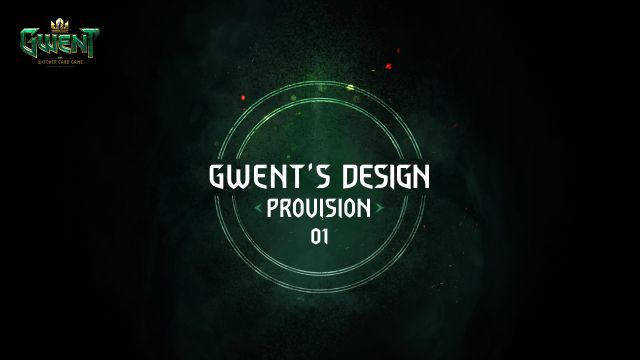
Welcome to this new article series on the Design of GWENT. Regularly, we’ll publish dive-in into the big concepts that make GWENT, design philosophies and other appropriate topics. We encourage you to reach out on topics you would like to see being dissected in this column!

Written by Gameplay Designer Jean Auquier
One of the massive changes introduced to GWENT with Homecoming is the provision system. Beta players will remember a time during which a third color existed alongside Bronze and Gold: Silver! Decks were made of a maximum of 4 unique Gold cards, 6 unique Silvers, and at least 15 Bronzes (with a limit of 3 copies per card).
Today, let’s explore the Provision system from what stemmed its introduction in GWENT to the impact it has on the game.
To begin, the Provision system is in fact an evolution of the color limitations which already existed in Beta GWENT. So understanding why that system existed in the first place is a good start.
In a majority of competitive card games, systems exist in order to segment cards. One of the most common one, popularised by Magic: The Gathering, is the mana system, also used by games like Hearthstone or Legends of Runeterra. Other systems also exist, for instance Yu-Gi-Oh has used multiple variations of sacrificing one own units to play a stronger one while Weiss & Schwarz uses a level system under which higher level cards can’t be used until later in the game (when one is getting closer to losing). Coming back to GWENT, the past color limitation system and the current provision one both segment cards through deck building restrictions.
By segmenting cards as such, cards can be of different average values between each pool because they are pitted against other cards of the same pool instead of all the cards in the game. Ordering these pools by average value is called the “power curve” as it allows one to visualize how value evolves between pools. For instance, Mana systems commonly present an exponential increase rather than a linear one as higher cost cards turn out to be much less flexible than lesser ones, requiring in turn to be significantly stronger.
The point of all of this? More design space! Limitations breed creativity. As to how it benefits GWENT specifically, the game is at its core an auction. Assuming both players start the game with the same amount of points to spend, the goal is then to win rounds with the smallest point difference possible and on the contrary to lose rounds with the largest difference, meaning your opponents wasted points. That way you can end up with more points in the final round. Having cards of different point value makes this objective more complex and more interesting, especially considering the gameplay is turn-based.
With that out of the way, the evolution from the color limitation system to the provisions one becomes easier to explain. By going from 3 pools (Bronze, Silver and Gold) to about 10 and more (from 4 provisions to 13+), more design space is opened.
This doesn’t come without a price however. The color limitation system offered a pretty low barrier of entry. Since there were heavy deck building restrictions, all you had to do was to pick your Golds, Silvers and Bronzes while being mindful of synergies, no extra questions asked! Heck, since you needed 15 Bronzes and could run 3 copies of each, you were even getting away by just picking 5 Bronzes. Making adjustments to your deck was also easy as synergies aside, adding/removing a card could only affect its own pool.
Compare with the Provision system, questions like “How many high end and how many mid end cards should I have?” and “How should my Bronzes provisions be spread?” starts to arise (questions similar to ones you might ask yourself about your mana curve or your land spread in other games).
On top of that, making a change to the deck can have a direct impact on the rest of the cards as you try to perfectly fit for the provisions available to you. This, however, can be beneficial. By restraining the deckbuilding, the provisions system ends up answering its own questions quite naturally. The usual process involves quickly whipping the deck out by putting in the cards ones want to play, then proceeding to meet the provision limit by adding higher or lower provision cards and finally refining it by moving provisions around.
The minimal (and as such optimal) deck size plays a big role in that regard. Provisions systems in other games often don’t include strict limitations on the number of elements that can be included. It’s up to the player to decide to run a low number of elements with high provisions or more elements but diluting the provision limit in the process. By having a clear number of cards between which provisions must be shared in Gwent, players can avoid these dilemmas and focus on deciding how to allocate provisions.
Speaking of which, with a base provisions of 150, leader allocating on average 15 more and having to fit 25 cards in the deck, the average provisions allocatable per card is around 6.5. Adding a card in the deck under this provision limit allows another card in the deck to be more expensive, and vice versa. For instance, running a 4 provisions card frees 2.5 provisions which can be used to run a 9 provisions card or any other combination for that matter. Fitting a 14 provisions card like Haunt in your card requires you to run three 4 provisions cards to compensate for it!
This brings us to one of the most important topics brought by the provision system: Polarisation. Without considering card effects, in a game of Gwent only 16 cards out of the 25 that makes a player deck can be played. If all cards are close to the provision average, this means that around 60 provisions are not actually used in a game of Gwent. By “polarising” one’s deck, meaning introducing higher cost cards and as a result lower cost ones, this unused provision total can be brought down (if only the lower provision cards remain)... as well as up! This risk of missing out on value (draw your golds!) increases the more a deck is polarised. It’s also nothing new, this risk also existed with the color system. The provision system just lets players control how polarised their deck is.
While polarising one’s deck introduces risk, the Mulligan mechanic allows one to mitigate that risk quite a bunch which makes it one worthwhile to take. Because of this, 4 provisions cards inherently are “mulligan fodder”, cards which you don’t want to play and are just included to allow you to play more expensive ones.
This is one of the limitations of the provision system with the way it works in GWENT. This, by the way, is the reason why cards with provisions lower than 4 will (most likely) never be introduced in Gwent. 0 provisions cards have actually been toyed with during the development of Homecoming, but they basically were “free provisions” to allocate to other cards and their value (or rather lack thereof) didn’t matter since they would always be mulliganed away during games.
This is also the reason behind the increase of Bronze's value over the years. Along with a focus on synergies, it allows us to make it less of a loss to actually play some of them (and miss on provisions), and even make it desirable.
Another interesting observation is that since 4 provisions don’t have to be part of your main game plan, they are a great spot to include tech options: cards that cover specific cases. Players have long known about cards like Squirrel but other examples include Purifies, a bunch of them having been moved to 4 provisions with patch 9.4.
Until now we were leaving out card effects, but with thinners and tutors, one is able to tap into this pool of unused provisions... For a price that is. Imagine a world in which one provision is equal to one point. Being able to finish the game with fewer cards in your deck than your opponent means you got to use more of your provisions, meaning you had more points to play!
This is why this kind of effect often comes with a hefty price in terms of points. Advantages like consistency and big point output aside, we must balance the fact that you’re partially making use of a pool of provisions that would have otherwise been unused. This is also why when evaluating a thinner, 4 provisions must be subtracted to the sum of the thinner and the thinned card’s provisions as 4 is the minimum provision that would have been left unused in your deck if you hadn’t thinned otherwise. Taking the simple example of playing two Impera Brigade, the total value is 8 while the total provisions is 10. Removing the 4 extra provisions the card removes from the unused pool brings it to a 8 for 6 combo play (plus the intrinsic value in terms of consistency that comes with thinning), which is far more understandable that 8 for 10.
Interestingly, the reverse thought process can be applied to Echo cards. Since the deck is thickened by the card coming back to it, more provisions will be left unused which is disadvantageous and this needs to be taken into account in the value of the card. To properly evaluate it, 4 provisions must be added to its cost because that’s the (minimum) provisions playing an Echo card twice is making you miss.
I have painted polarisation in a bad light until now, but it is actually something that we desire and that we have been encouraging (to a degree).
While polarisation increases the variance of decks in terms of potential points output, we feel like it’s mitigated enough by the natural mechanics of the game as well as the stronger consistency tools which have been introduced to the game over the years.
But most importantly, polarisation creates engaging gameplay! Larger differences between cards also means more complexity and depth in the auction system. We’ve all experienced the conundrum of having to play a high-end card when only a low-end one would suffice, and the feeling of waste that comes with it. Due to this, it’s sometimes even the right play to mulligan some high-end cards away in earlier rounds because you don’t want them to be bled.
High provisions cards also make for major archetype landmarks, which are fun to build around (think of the impact of Scenarios!). This is part of why there has been a bigger focus on introducing high provision (meaning 11+) cards in recent expansions.
To conclude this article, while it can be tempting to simplify GWENT to a battle of provision, it is important to remember that it is much more than that. Synergies between your cards, interrupting opponent’s synergies and plays with wide value ranges (ie. Heatwave) are all tools that can allow players to “generate” value. And the most important one of all is the agency over how these points are split between rounds. Even if your opponent has more points available, the fact that they have to split between 3 rounds means that there will still be ways to win!
And as a bonus, I highly recommend checking out Gorflow’s great video on “The rule of 16” on the youtube channel of The Council (



